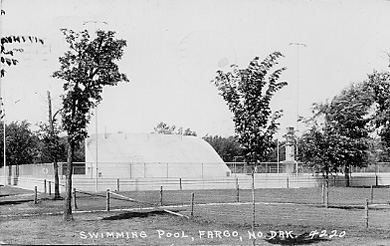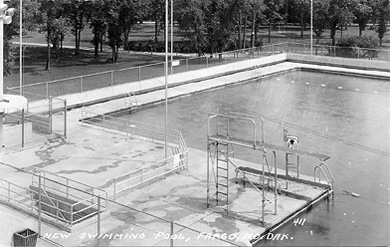Island Park
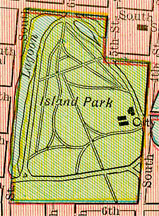
Island Park was part of the original townsite of Fargo platted out by the Northern Pacific Railroad. Jacob Lowell, Jr. and J.B. Power interceded with the railroad and the area that is now Island Park was deeded to the city for a park.
The map on the right is taken from an 1899 Fargo street map. One can see the many paths through the park. On the west (left) side is a lagoon and on the east side are several unidentified structures and a circular wading pool.
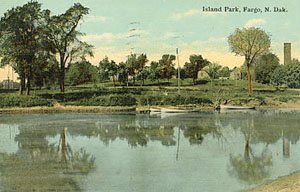
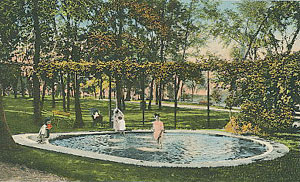
Boating on the river appeared to be a tranquil pastime based on the 1911 postcard to the left. The chimney on the right side is from the old Fargo water plant which stood in the park just south of today's Fargo Moorhead Community Theater building.
The wading pool pictured on the right also appeared to be popular.
The most popular attraction of the park was probably just strolling along its many paths as seen in the postcards below.
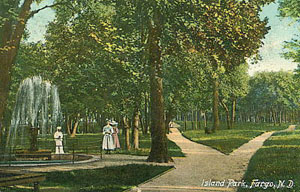
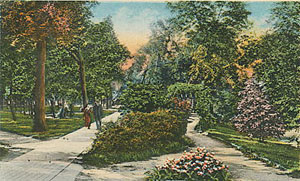
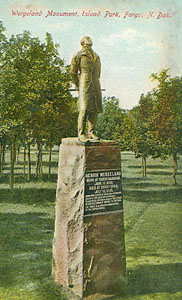
To the right, one can see the statue of Henrik Wergeland (1808-1845), which stands in Island Park. Wergeland was Norway's national poet and a symbol of Norway's independence. Wergeland's literary works were used to lead his country toward independence from Sweden in 1905. He was a reformer of politics, religion, agriculture and prisons, and he has been called "the Abraham Lincoln of Norway." He is largely credited with making May 17 the day Norwegians celebrate their independence.
The statue of Wergeland was unveiled in Island Park on Wednesday, June 17, 1908, as more than 3,500 people watched. The Fargo forum reported that area businesses closed early so employees could attend.
Dr. Herman Fjelde of Abercrombie, ND, first commissioned the statue by Gustav Vigeland, Norway's leading sculptor. In 1906, Abercrombie residents planned to build an Old Settlers park on the site of its historic fort. Fjelde and others who had strong ties to the Norwegian aristocracy, hired Vigeland with $500 down. Soon, however, Vigeland's work on the life-size sculpture was then taken over by a Norwegian group and the $500 refunded. There was a dispute over installing the work of such an important artist in the town because of its remoteness. Instead it was sent to Minneapolis, though a final resting place for the piece had not been determined.
Committees from Minneapolis, St. Paul, Chicago, Grand Forks and Fargo bid for the statue, with Fargo winning. On June 17, 1908, the statue was dedicated in its current location, marking what would have been Wergeland's 100th birthday. An identical bronze statue was unveiled in Oslo the same day.
The sculptor of the Wergeland statue was Gustav Vigeland, one of Europe's most well known sculptors. Evidence shows he was working on the Wergeland piece as far back as 1897, at least nine years prior to being hired for the project.
Vigeland is best known for nude statues of men and women, especially those engaged in erotic poses, which put him at odds with the anti-sexual morals of his time. Today Norway honors Vigeland with a museum and park bearing his name in Oslo. The Wergeland statue in Fargo is one of the rare Vigeland works found outside Norway.
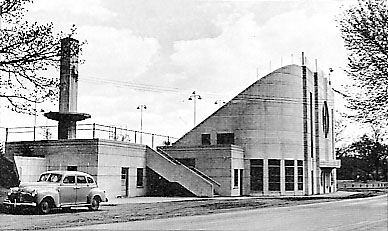
During the depression of the 1930's, the Federal Government's Works Progress Administration built many public facilities. One such edifice was Fargo's public swimming pool in Island Park. The pool was designed by Fargo architect S. Marius Houkom (1891-1980). In the postcard to the right, we are looking southeast at the building's entrance. On the entrance level were the men's and women's locker rooms One then walked upstairs to the pool. There were two high diving boards and two low diving boards. There was also a quite large concrete bleacher on which to watch the activity. This swimming pool has since been replaced by a new facility.
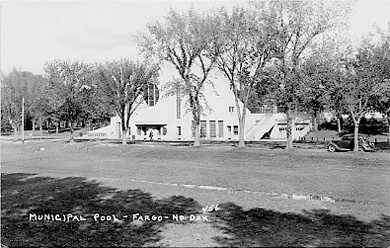
During the late 1950s or early 1960s, another swimming pool was built. Called the Harry Howland pool, it was located at the southeast corner of the Red River Valley Fairgrounds, near Broadway and 17th Avenue North. It was smaller than the Island Park pool. I worked there several summers as "basket boy." Patrons of the pool were given metal baskets in which to put their clothes. I stored and retrieved them and cleaned the locker rooms three times a day (after morning swimming lessons, at dinner time, and at closing). Good summer job. I was too young to take the Red Cross Life Saving course required to be a Life Guard.
